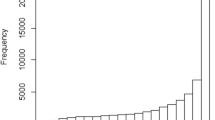Abstract
It has been suggested that classifiers in Chinese serve a semantic function of categorizing the nouns in terms of their perceptual and functional features. In this study, we investigated the classifiers’ organizational utility in a recall task by contrasting it with that of taxonomic categories. Chinese and English participants studied and immediately recalled two lists of nouns, one associated with four taxonomic categories and the other with four classifiers. The nouns were presented randomly in bare forms or in columns labeled by category names or classifiers. Substantial subjective clustering effects were found in the recall of taxonomically categorized nouns whether they were presented randomly or in labeled columns. The recall of classifier categorized nouns showed no clustering when presented randomly, but some clustering when presented in labeled columns. The findings indicate that (1) classifiers do not serve as a spontaneous memory organizational device among Chinese speakers, (2) when used as such under specific circumstances (e.g., explicitly cued), they are not as effective as taxonomic categories, and (3) Chinese speakers benefit more from explicit labels of classifiers than English, which hints at an indirect language effect. These findings suggest that classifiers are analogous to the so-called ad hoc categories, the constancy of which relies on the degree features shared among the member nouns, as well as the frequency with which speakers are exposed to these nouns as a group, which includes the linguistic experience of using the same classifier to refer to them.
Similar content being viewed by others
References
Ahrens, Kathleen. 1994. Classifier production in normals and aphasics. Journal of Chinese Linguistics 22: 202–247.
Aikhenvald, Alexandra Y. 2004. Nominal classification: Towards a comprehensive typology. Sprachtypologie und Universalienforschung 57: 105–116.
Allan, Keith. 1977. Classifiers. Language 53: 285–311.
Barsalou, Lawrence W. 1983. Ad hoc categories. Memory and Cognition 11: 211–227.
Bousfield, W.A. 1953. The occurrence of clustering in the recall of randomly arranged associates. Journal of General Psychology 49: 229–240.
Bransford, John D. 1979. Human cognition: Learning, understanding, and remembering. Belmont, CA: Wadsworth.
Chao, Yuenren. 1968. A grammar of spoken Chinese. Berkeley: University of California Press.
Croft, William. 1994. Semantic universals in classifier systems. Word 45: 145–171.
Croft, William, and D. Alan Cruse. 2004. Cognitive linguistics. Cambridge: Cambridge University Press.
Freedman, Jonathan L., and Elizabeth F. Loftus. 1971. The retrieval of words from long-term memory. Journal of Verbal Learning and Verbal Behavior 10: 107–115.
Frender, Robert, and Peter Doubilet. 1974. More on measures of category clustering in free recall—Although probably not the last word. Psychological Bulletin 81: 64–66.
Gao, Ming Y., and Barbara C. Malt. 2009. Mental representation and cognitive consequences of Chinese individual classifiers. Language and Cognitive Processes 24: 1124–1179.
Hsu, Mei-ying. 2011. The MDS and cognitive research of measure words of shape. Master thesis, National Pingtung University of Education, Pingtung, Taiwan.
Kuo, Jenny Yi-chun, and Maria D. Sera. 2009. Classifier effects on human categorization: The role of shape classifiers in Mandarin Chinese. Journal of East Asian Linguistics 18: 1–19.
Labov, William. 1973. The boundaries of words and their meaning. In New ways of analyzing variation of English, ed. Charles-James N. Bailey and Roger W. Shuy, 340–373. Washington, DC: Georgetown University Press.
Lakoff, George. 1987. Women, fire, and dangerous things: What categories reveal about the mind. Chicago: Chicago University Press.
Lin, Emilie L., and Gregory L. Murphy. 2001. Thematic relations in adults’ concepts. Journal of Experimental Psychology: General 130: 3–28.
Little, Daniel R., Stephan Lewandowsky, and Evan Heit. 2006. Ad hoc category restructuring. Memory and Cognition 34: 1398–1413.
Myers, James. 2000. Rules vs. analogy in Mandarin classifier selection. Language and Linguistics 1: 187–209.
Nisbett, Richard E. 2003. The geography of thought: How Asians and Westerners think differently … and why. New York: The Free Press.
Pellegrino, J.W., and L.J. Hubert. 1982. The analysis of organization and structure in free recall. In Handbook of research methods in human memory and cognition, ed. C. R. Puff, 129–172. New York: Academic Press.
Saalbach, Henrik, and Mutsumi Imai. 2007. Scope of linguistic influence: Does a classifier system alter object concepts? Journal of Experimental Psychology: General 136: 485–501.
Schmitt, B., and S. Zhang. 1998. Language structure and categorization: A study of classifiers in consumer cognition, judgment and choice. Journal of Consumer Research 25: 108–122.
Srinivasan, M. 2010. Do classifiers affect cognitive processing? A study of nominal classification in Mandarin Chinese. Language and Cognition 2: 177–190.
Tai, James H-Y. 1994. Chinese classifier systems and human categorization. In In honor of Professor William S-Y. Wang: Interdisciplinary studies on language and language change, ed. Matthew Chen and Ovid Tseng, 479–494. Taipei: Pyramid.
Taylor, John. 2002. Cognitive grammar. Oxford: Oxford University Press.
Tien, Yi-Min, Ovid J.L. Tzeng, and Daisy L. Hung. 2002. Semantic and cognitive basis of Chinese classifiers: A functional approach. Language and Linguistics 3: 101–132.
Tulving, E. 1962. Subjective organization in free recall of “unrelated words”. Psychological Review 69: 344–354.
Ungerer, Friedrich, and Hans-Jorg Schmid. 1996. An introduction to cognitive linguistics. Essex: Longman.
Vervaeke, John, and Christopher D. Green. 1997. Women, fire, and dangerous theories: A critique of Lakoff’s theory of categorization. Metaphor and Symbol 12: 59–80.
Zhang, Shi, and Bernd Schmitt. 1998. Language-dependent classification: The role of classifiers in cognition, memory and ad evaluation. Journal of Experimental Psychology: Applied 4: 375–385.
Author information
Authors and Affiliations
Corresponding author
Rights and permissions
About this article
Cite this article
Huang, S., Chen, JY. The effects of numeral classifiers and taxonomic categories on Chinese and English speakers’ recall of nouns. J East Asian Linguist 23, 27–42 (2014). https://doi.org/10.1007/s10831-013-9108-0
Received:
Accepted:
Published:
Issue Date:
DOI: https://doi.org/10.1007/s10831-013-9108-0




